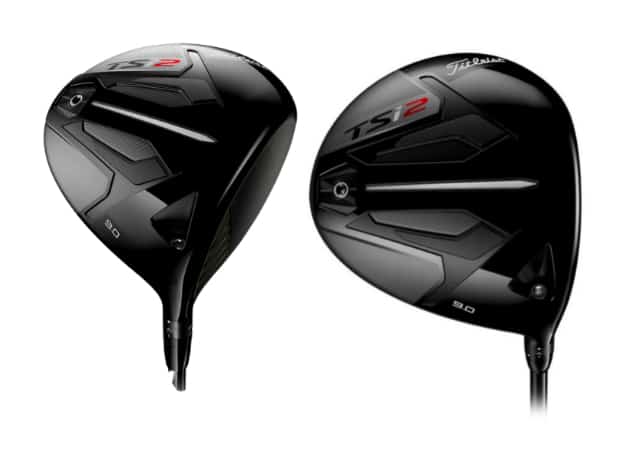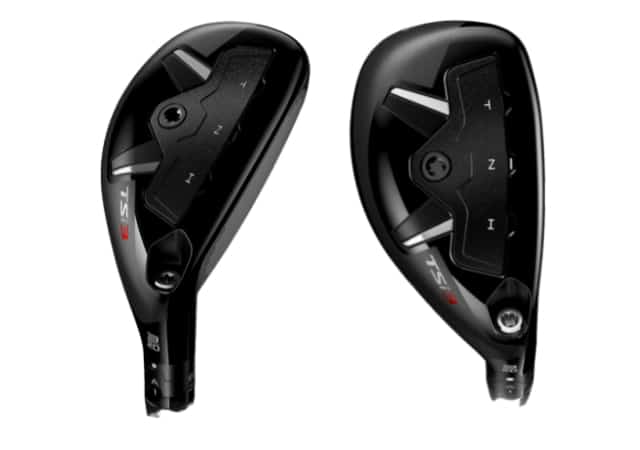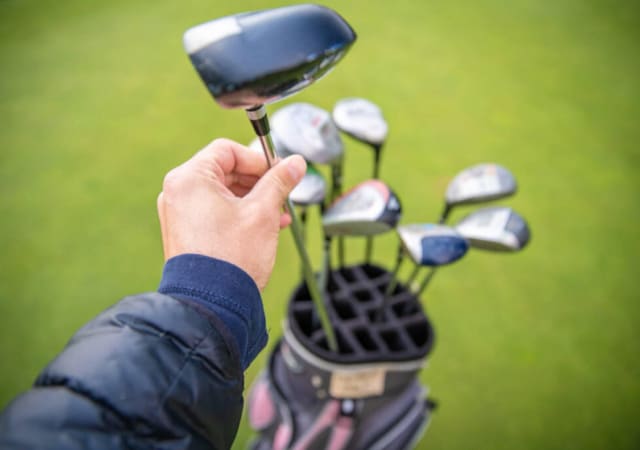The traditional golf bag included a quality driver, a 3-wood, a 5-wood, and a 3-PW with a SW and a putter. But with the introduction of hybrid clubs, Numerous golfers are now unsure whether they should stick to their old woods or go with the new hybrid wave.
With a maximum of 14 golf clubs permissible in your bag, selecting the most suited to your game can be challenging, especially when deciding between a 5-wood and a 3-hybrid.
In this article, we will make the choice easier by answering the question once and for all.

Which One Should I Carry?
Distance plays a significant role in decision-making. In terms of distance, a 17-degree 3-Hybrid is comparable to an 18-degree 5-wood. However, the club’s length and head size vary. This can have an effect on swing outcomes such as workability. For instance, a 5-wood may be simpler to hit off the tee, whereas a 3-hybrid may offer a greater variety from the fairway or rough. In the end, the decision frequently comes down to which club provides you with the most consistency. It would be best to remember that consistency breeds confidence and results in lower scores!
5-Wood Vs 3-Hybrid Comparison
Both hybrids and woods come in different varieties. Let’s now explore how a 5-wood and a 3-wood differ in terms of shape, size, length, use, etc.
5-Wood

Amateur players should carry between two and three hybrid clubs in their golf bag to replace clubs such as the 5-wood and 3- and 4-irons. The overall number of hybrids required by a golfer is best decided by clubhead speed, distance gaps between clubs, personal choice, playing objectives, and budget.
The 5 Wood is an excellent club for consistently driving the ball toward the green from a relatively long distance. In addition, having a 5 wood for shorter tee shots and a longer approach shot makes the most sense for an average player.
Easier to Hit off the Tee
The 5 wood’s size advantage over a 3 hybrid makes it easier to hit off the tee. This gives you an advantage on shorter, narrower par 4s and longer par 3s where an iron is insufficient.
Apart from the added loft, the 5-wood looks identical to a 3-wood, which might provide confidence when hitting it off the tee. If you are someone who frequently prefers to strike something other than the driver for safety reasons or if you have difficulty with your driver, the 5-wood may be a better option.
However, if you are a frequent pull driver and do not intend to use a 3 or 5 wood, the hybrid may be the best option.
Less Likely to Hook
Professionals and golfers with a low handicap who have little difficulty controlling their ball flight may prefer a 5-wood over a 3-hybrid.
This is because many players are wary of utilizing a hybrid, believing it will draw the ball further than its regular flight path and maybe result in the dreaded hook.
The hybrid’s design elements make it easier for players with a higher handicap to hit a power draw. Those with a chronic slice will benefit from a hybrid, while more proficient players who routinely draw will benefit from a 5-wood.
Potentially Bigger Yardage Advantage
The 5-wood may fly further than the 3-hybrid due to the size of the head and the length of the shaft. Once again, a variety of variables are at play here.
In certain circumstances, such as off the tee or from a perfect lie, the 5 wood may fly further and produce more total distance. However, when confronted with tight lies or thicker terrain, the hybrid may prove to be the superior alternative.
3-Hybrid

The 3-wood is a member of the wood family of clubs and has been around for a long period of time. It is designed to provide the additional distance required on long par 4’s and par 5’s.
The hybrid club is a relatively new addition to the game of golf, developed in response to golfers’ struggle to consistently and correctly strike their long irons. The 3-hybrid is not a distance club in the traditional sense.
This club is suitable for everybody; it simplifies long-range approach shots and instills confidence in your long game. The high launch and spin rate will assist you in holding greens from a distance, allowing you to strike from further out.
Hybrid clubs are intended to be used in place of a golfer’s 2-iron through 5-iron clubs, depending on the golfer’s desire. Many golfers struggle with long irons and therefore opt for a more forgiving hybrid.
Hybrids are Designed to Be Easier to Hit Than Fairway Woods.
As the name suggests, a hybrid is a cross between an iron and a fairway wood. In terms of appearance, construction, and function.
The phrases ‘hybrid’ and ‘rescue club’ are sometimes used synonymously. They are incredibly adaptable as a club type, providing both distance and a higher launch. Many golfers opt to replace their fairway wood or long iron with a hybrid.
However, choosing the right tee size can significantly impact your ability to make solid contact with a fairway wood. For beginners, an ideal tee height for beginner golfers can help address common issues and promote a clean strike.
Increased Adaptability in the Rough and Off of the Fairway
While the 5-wood is more forgiving off the tee, the 3-hybrid is a more versatile club in the fairway and rough, as it is capable of being employed in almost any situation.
Certain golfers may even choose to use it to bump and run around the greens. The hybrid appears to have evolved from clubs such as tight lights or rescue clubs, which were meant to allow players with a mid to high handicap to get the ball in the air and play the longer par 4s or par 5s.
Provides a Higher Loft Option
Today’s hybrids are quite easy to get a loft, which is advantageous if you frequently find yourself in the 180-200 yard zone and need to stop the ball on the green.
Nothing is more disappointing than carrying the ball to your planned landing spot only to have it roll through and off the green. This added loft will assist you in carrying the ball further and increasing your chances of keeping it on the green.
Here’s an informative video (12 minutes 21 seconds) from James Robinson Golf‘s YouTube Channel. Watch to see the actual difference between a 3-hybrid and a 5-wood when in action.
Factors to Consider
Your height, body type, and physical strength are all critical factors to consider. As a general rule, taller players require a longer shaft to perform optimally. Additionally, you should analyze the shaft flex and how well it fits your swing. Other factors include the following:

Distance
Evaluate the distance you typically achieve with each type of club. If you need more distance, the 5-wood might be a better choice, as fairway woods generally hit the ball farther than hybrids.
Launch and Trajectory
Consider the launch angle and trajectory you prefer. Hybrids tend to have a higher launch and a more penetrating ball flight, while fairway woods like the 5-wood have a lower launch and a longer carry.
Swinging technique
When using a fairway wood, a golfer’s swing plane should be a bit flatter. The clubface should be parallel to the ground as it strikes the ball off the fairway.
A hybrid club enables the golfer to approach the ball from a steeper angle, similar to the way an iron club is struck. A well-placed hybrid shot can leave a divot that extends slightly beyond the point of impact.
Shot Shape
A draw is a challenging shot for the majority of amateurs, but with a few easy tweaks, any player can learn how to hit a draw. Not only does it carry further, but it also rolls further. Draws generate greater topspin, which results in an increased rollout once the ball hits the ground. The further you can hit off the tee, the closer you will be to approach shots and, consequently, the lower your score will be.
Hybrids are generally easier to shape, allowing for draws or fades, while fairway woods like the 5-wood might be less adaptable in shaping shots.
Forgiveness
To begin, hybrid clubs are far more forgiving to handle than a wood or a driver. While a 5-wood will normally have a loft of around 19 degrees, a 3-hybrid will typically have a loft of around 20 degrees. That implies that when you strike the ball with a wood, it’s much more difficult to lift the ball into the air due to the golf club’s more acute angle of contact.
Hybrid golf clubs provide a far higher MOI (moment of inertia) [1] and a significantly lower center of gravity, which results in much more fluid contact with the ball and prevents the clubhead from twisting or turning during impact.
Hybrids offer more forgiveness than fairway woods.
Versatility
Hybrids are often more versatile, suitable for various lies and situations, including rough, fairway, and even from the tee.
Fairway woods like the 5-wood are better suited for shots off the fairway or tee, offering more distance but potentially less versatility in challenging lies.
Frequently Asked Questions
The following are the most frequently asked questions regarding the topic.
Who Should Use a 5-Wood?
We already know that the five wood is a fantastic choice for people seeking distance.
If you’re having difficulty achieving the performance you require off the tee and are searching for an alternative, the 5-wood is an excellent solution.
Another reason to carry a five wood is if your swing is slower and you frequently miss the green on par four or par five holes. Senior, female, and junior golfers alike frequently carry a five wood in their bag.
Golfers who may choose to avoid the 5-wood are those who frequently find themselves in the rough or wish to shoot at a pin.
Who Should Use a 3-Hybrid?
3-hybrids are popular with golfers of different levels, from absolute beginners to scratch golfers. Numerous LPGA players carry hybrids and have excellent success with them. The following can benefit from using a hybrid club:
– Beginners and high-handicap golfers:
A 3-hybrid can be more forgiving and easier to hit than a long iron, making it a good choice for players who are still developing their swing and struggling with consistency.
– Golfers with slower swing speeds:
Hybrids are designed to help launch the ball higher and achieve greater distance, making them a great option for players with slower swing speeds who may struggle to generate enough height and distance with long irons.
– Players looking for versatility:
A 3-hybrid is a versatile club that can be used in various situations, including hitting from the fairway, rough, or even off the tee. It offers more forgiveness and easier launch compared to long irons, making it a reliable club for a variety of shots.
– Those seeking a balance of distance and control:
A 3-hybrid can provide a good compromise between the distance of a fairway wood and the control of an iron. It offers decent distance off the tee or fairway while still providing the ability to shape shots and control trajectory.
– Players replacing long irons:
Many golfers struggle with long irons (such as 3-irons) due to their low loft and smaller sweet spot. A 3-hybrid can serve as a suitable replacement, offering more forgiveness, higher launch, and easier playability.
How Do I Choose Clubs?
Whether you’re still unsure or perhaps leaning toward a particular club, we would urge that you give both clubs a try. Visit a local golf store with a simulator and put both to the test. A professional club fitter will help you choose the best clubs for your game.
Consideration should be given to club speed, ball speed, curve, and spin rate. Take care that the spin rate is not excessive. The spin rate should be between 3500 and 5500. Anything more results in distance loss and an excessive spin rate for a club in this category.
The ideal situation is to find a friend who has a 3 hybrid or a high-quality 5 wood and compare the two. Make at least five to ten shots to gain confidence and determine what works best for your game.
Final Thoughts
Choosing the appropriate bag makeup for your game is straightforward: The more you experiment with, the more data you will have, and the more educated conclusions you will be able to make. As is customary, the answer is found in the data.
Both the 5-wood and 3-hybrid are extremely handy in different situations; that’s why we provided factors to consider while choosing one club over the other. It all comes down to your skill level, mastery and speed of the swing, goals, and preferences.
If you have any questions in mind, don’t hesitate to contact us.
Thanks for reading!
References:
- Why is MOI Important to My Game?. PGX. Retrieved from https://www.pxg.com/ar-ae/about/news/why-is-moi-important-to-my-game




